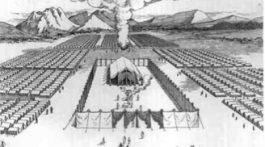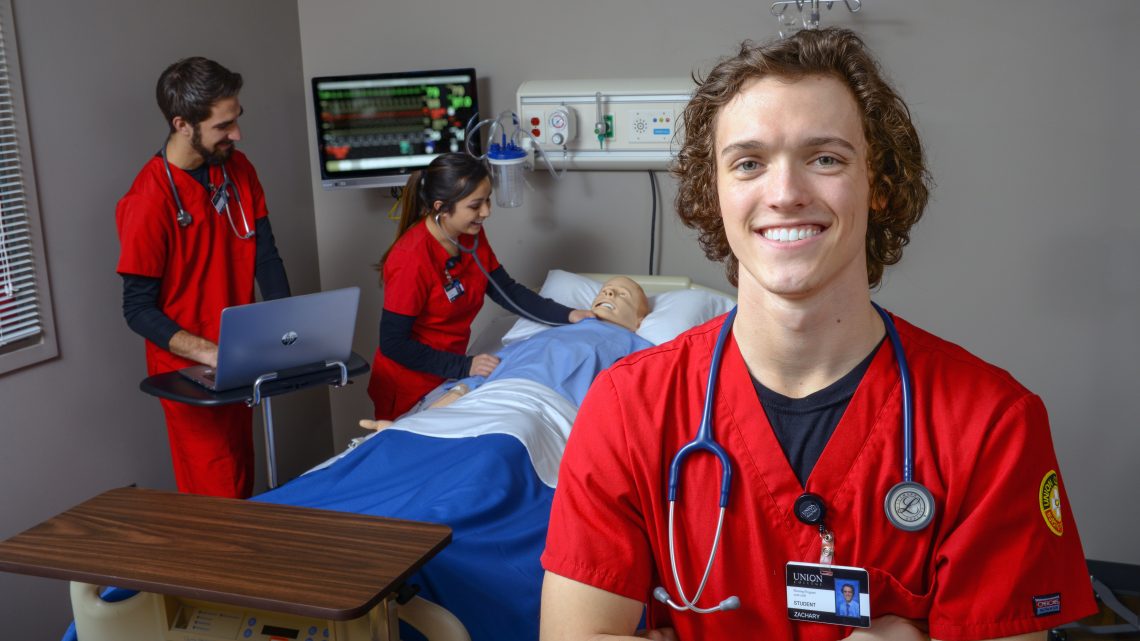For nursing students like Zachary Krall, learning to make life-and-death patient care decisions can be a daunting challenge. But thanks to Union College’s newly expanded Nursing Simulation Center, Krall can practice in an environment even closer to the real thing, with interconnected rooms, high-tech patient simulators and volunteer patients who mimic the experience of a real hospital.
“I’m glad I can build confidence in my ability to work effectively in a variety of settings before working with actual patients in a hospital,” said Krall, a junior nursing major from Washington. The patient simulators look like people and mimic human bodily functions, allowing students to feel a pulse, assess pupil reaction, listen to lungs, respond to a patient’s voice and see reactions to medication.
“Union’s simulation center experience is different from clinical training in hospitals,” Krall said. “During simulations, we make patient care decisions on our own and see the results of our choices.”
Tracy Hagele, the coordinator of Union’s Nursing Simulation Center, said, “Simulation offers the only opportunity for students to practice the full scope of nursing skills before they actually become a nurse. Our program is unique because we emulate a real hospital. The nursing students work together as a team to care for several patients in multiple rooms—just like they will in a hospital unit—but without a clinical instructor looking over their shoulder. Instead, we watch from the control room to provide constructive feedback during the debrief.”
The Union College difference
Krall first visited campus in August 2016, when he helped his brother move into the residence hall.
“The faculty gave me a tour of Union’s nursing program even though I had no intention of transferring,” said Krall, who was already enrolled in a nursing program in Florida. His interaction with faculty, the campus atmosphere and the experiential learning emphasis impressed Krall. The simulation center especially caught his eye—his previous college didn’t have one.
Even with the transfer deadline six months past, the nursing faculty helped him begin the process. “I prayed about it, and three days later, I transferred to Union,” Krall said. “It was a miracle.”
One semester later, Krall knows he made the right decision. “I feel like I’m getting the preparation I need to be a great nurse,” he said. “At Union, the faculty really focus on helping you succeed.”
He believes the hands-on practice through the simulation center is helping him gain more confidence in clinicals and in classwork. In fact, a recent study by the National Council of State Boards of Nursing found nursing simulation prepared students just as effectively as traditional clinical rotations in hospitals. At Union, nursing students participate in a combination of simulation and clinical rotation experiences.
Expanding to create a hospital environment
According to Hagele, a lot of nursing schools focus on single patient simulations—one student working with one simulator. At Union, nursing students must work as a team to care for several patient simulators and live patients. During simulations, each nursing student talks with their patients, performs physical assessments, reviews patient charts with physician orders and lab results, retrieves and administers appropriate medications and records information on the patients’ electronic health record. “This innovative method better simulates real-world nursing practice,” Hagele said. “We specifically design the simulations to help them translate the skills they are learning in the classroom to the clinical setting.”
Dr. Nicole Orian, chair of the Division of Nursing, believes Union’s unique approach to simulation is one of the reasons their graduates pass the NCLEX-RN the first time. “Union has a consistently high first-time pass rate on the national nursing licensure exam—the highest in the state of Nebraska in 2015 (94 percent) and with a 97 percent first-time pass rate in 2016, we expect our graduates will be at the top once again,” she said.
A simulation can take anywhere from 20 minutes to two hours. Hagele sets up the simulation center to replicate a variety of environments. Often the center is set up like different hospital units such as a pediatrics, emergency or recovery. At other times, Hagele recreates other types of settings: an apartment for home health training or a small village to prep Global Health Nursing students for their time in Nicaragua.
“You’re not overwhelmed,” Krall said. “You can focus and make sure you’re completing the proper steps without being rushed.”
Hagele stated that the recent expansion doubled their simulation space and provided them with an additional suite and two new high-tech manikins. “We can now accommodate more nursing students while continuing to maintain multiple patient simulations. This also allows students at different levels to work together as a team and learn from each other,” Hagele said.
After each simulation, students debrief together with supervising faculty to review thought processes, evaluate care decisions and learn from the experience—something Krall finds valuable. “Debriefs are a good time to ask questions because you’re allowed to be vulnerable and receive clarification,” he said. “It’s better to get everything fixed in simulation than on the floor with a real patient.”
By combining practical experience with individualized learning, Krall feels his education at Union is well rounded. “At Union, I don’t get overwhelmed and feel like giving up,” he said. “We learn a lot about holistic care. We’re taught to treat the person and not the disease. We care about the person’s well-being emotionally, spiritually, physically and psychologically, just like the nursing faculty care about us.”
If you are interested in learning more about Union College’s nursing program, please visit www.ucollege.edu/nursing or call 402.486.2674.
—Emily Wood is a senior communication major from Missouri.








